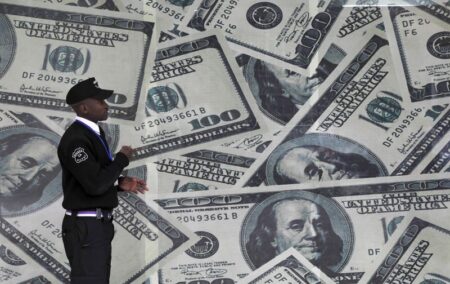By Joice Alves and Kevin Buckland
LONDON/TOKYO (Reuters) -The dollar weakened against the yen on Wednesday after top Japanese currency officials warned against what they described as rapid and speculative yen moves, while sterling fell after data showed UK inflation did not accelerate in January as expected.
“We are watching the market even more closely,” Japan’s Finance Minister Shunichi Suzuki told reporters. “Rapid moves are undesirable for the economy.”
Asked whether authorities could intervene in the currency market, Suzuki left his office without a word.
Earlier, Japan’s top currency diplomat Masato Kanda said the nation would take appropriate actions on forex if needed.
The dollar fell 0.14% against the yen to 150.57, and was not too far from a three-month high hit against the Japanese currency on Tuesday. The dollar has added about 10 yen in price since the start of this year.
Japan intervened in the currency market three times in 2022 when the yen plunged to 32-year lows near 152 yen to the dollar, conducting rare dollar-selling, yen-buying intervention.
The dollar traded near three-month highs against major peers as traders again pushed back bets for the first Federal Reserve interest rate cut in 2024 following surprisingly hot U.S. inflation figures overnight.
“Fed expectations are pushing up against Japanese intervention expectations, and for now who the winner of this contest will be remains unknown,” said James Kniveton, senior corporate FX dealer at Convera.
Since data on Tuesday showed that the U.S. consumer price index (CPI) in January gained 3.1% from a year earlier, versus an estimated 2.9% rise, money markets have priced in no Fed cut in March and a 53% chance of a reduction in June, according to CME Group (NASDAQ:).
The dollar-yen pair tends to track long-term U.S. Treasury yields, which surged to a fresh 2-1/2-month peak of 4.332% on Wednesday.
Elsewhere, the British pound fell 0.3% to $1.2554, briefly touching a eight-day low against the dollar, after data showed UK inflation stood at an annual rate of 4.0% in January, unchanged from December.
Economists polled by Reuters had forecast an increase to 4.2%.
Steady inflation could possibly relieve some of the pressure on the Bank of England (BoE) to keep rates where they are for longer, analysts said.
“Base effects should now set up a very sharp fall in the annual inflation rate in the next four months,” said Michael Metcalfe, Head of Macro Strategy at State Street (NYSE:) Global Markets.
“This may yet be enough based on January’s benign reading to get the inflation rate near enough to target to allow the BoE to begin its easing cycle in June.“
Money markets see a 52% chance of a BoE rate cut in June and 75% chance of one in August, according to LSE Group data.
The – which measures the U.S. currency against six major peers, including the yen, euro and sterling – traded 0.05% higher at 104.91, not far from Tuesday’s three-month high of 104.96.
The euro edged 0.05% lower to $1.0703, after briefly dipping to a fresh three-month low of $1.0695.
Read the full article here












